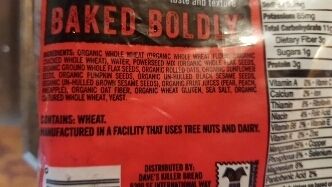Good article Clint. There are so many variations in what some people (myself included) consider a
good loaf of bread that one could say that that article only presents one side of the argument. There are many sides.
And I think that a lot of peoples eyes would glaze over half way through that article. I say that because they, in all likelyhood have never eaten a truly remarkable slice of bread. They think that the "name brand" loaf (you know, the one with the colourful bubbles on the plastic wrapper) is the best thing since, well since sliced bread

Even the "artisan" bread you pay $7 , 8 or 9 dollars at a real bakery has to cut corners. They have to make a loaf that will last longer than a day for mass consumption. I think it's in France where people buy their bread daily, not once a week. They don't use preservatives in their loaves so they don't last long. Storage of bread is a topic for another thread.
They say there are 5 main ingredients in a truly great bread: water, oil, salt, whole wheat flour and a starter. I disagree. But that's ony because I've found that creating and maintaining a starter is more work than I want to do.
Eyes starting to glaze over yet folks? Relax, I'm almost ready to get off my soap box

You'll notice they didn't mention yeast in those ingredients. There are two sources of yeast in their "recipe": the starter they use and the other is the air we breathe. That's why a "west coast" sourdough bread (usually a quite pronounced "sour" flavour) is totally different from what one might find in an east coast "sourdough" bread. It's the air!
My ideal bread (until I find a better one) only has 4 ingredients: water, flour, salt and yeast. My 3 pounds of dough will make 2 1 1/2lb loaves. For that, I use
less than 1/4 teaspoon of yeast. Conventional recipes use 10X that for a 1 lb loaf. I could go into why one uses so little yeast and the other so much but suffice it to say, I actually have three sources of yeast: the natural yeasts in the grain itself (yes, I grind my own flour from the whole grain), the natural yeasts that are floating in the air we breathe. And my one concession to man-made products, I add store bought yeast. That store bought yeast is my starter.
It gives the whole bread-making process a "kick start", otherwise the time to get everything active is more than I want to spend.
Enough of this.
You're a devil Clint, getting me started on this topic.
In the end, a good loaf boils down to quality (and the most SIMPLE) ingredients:
1) pure unadulterated flour (no bleaches, no preservatives, no "dough conditioners" (a euphemism for bleach)--tough to find but worth it,
2) pure water (unchlorinated is very important but not essential),
3) pure salt (not table salt) and either
4) instant or active dry yeast (it'll be your one concession to using a "store-bought" item)
Don't need oil (or any kind of fat), don't need milk (depending on what you're making) and don't need a starter (again, depends on what you're making). In fact, you don't even need store bought yeast (perhaps why it's not in their list). The bread making process will just take longer.
I'm done (for now; till someone posts their reply

)

